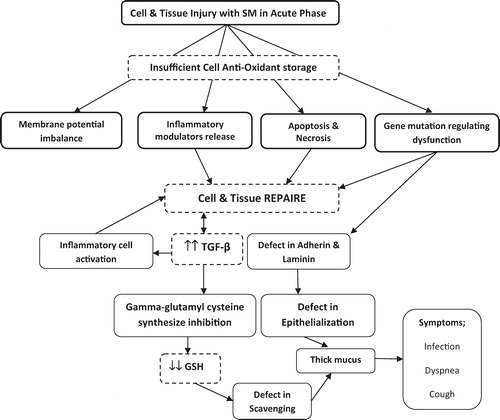Dear Editor
We have read with great interest the article entitled “Sulfur mustard and respiratory diseases” (Tang & Loke, Citation2012) published in Critical Reviews in Toxicology. Tang & Loke skillfully reviewed the literature on acute and chronic lung disorders post sulfur mustard (SM) exposure in addition to presenting their own research findings from in vitro studies. This review is a helpful article for resolving interpretations of the persistent respiratory complications of SM exposure. However, we would like to offer some additional points.
The article reviewed all data from acute to chronic phase and focused on treatment approaches for acute phase effects. However, it is important to recognize the need for more information on the treatment of chronic phase respiratory effects.
In terms of chronic respiratory complications, pulmonary fibrosis is not compatible with survival of patients. Other laboratory data to help in developing a prognosis are needed, including DLCO and body plethysmography findings. These issues are discussed by Ghanei et al. (Citation2008) and Ghanei & Harandi (Citation2007).
It is necessary to interpret the differences in various studies on the level of cytokines. IL-6 was previously suggested as being an important cytokine in pulmonary disorders (Attaran et al., Citation2010; Pourfarzam et al., Citation2009). The carcinogenic role of SM as well as other mechanisms has been discussed by Ghanei & Harandi (Citation2010).
In our opinion, other mechanisms of SM injury such as cell oxygen metabolism impairment need to be considered. It was previously shown that there is no significant relationship between the severity of lung injury (by imaging) and exercise test findings (Ghanei et al., Citation2011; Rezaian et al., Citation2008). These findings stated that oxygen demands can be affected in these cases due to less intolerance to exercise rather than the unexposed cases (Ghanei et al., Citation2011). Also, there is evidence which confirms the impact of mustard derivates on mitochondrial oxygen metabolism (Fedeles et al., Citation2011; Martens & Smith, Citation2008). Additional research, particularly genomic studies, are needed in this field.
Tang & Loke (Citation2012) focused on the molecular aspects of pulmonary disorders in SM injury, in our opinion they did not adequately consider the correlation between molecular aspects of SM injuries and clinical pathogenesis of SM. There is a need to use a “From Bench to Bedside” approach in considering the health effects induced by SM exposure. It is important to conduct laboratory investigations on the role of SM. The pathogenesis of specific lung diseases (such as Bronchiolitis obliterans or bronchitis) have previously been reported to provide insight into specific targets.
Finally, although they skillfully gathered and assessed the findings about chronic pulmonary effect of SM, they did not interpret the findings in an integrated manner. shows the approach to describing the mechanisms of chronic pulmonary consequences of SM exposure based on our previous research (Ghabili et al., Citation2011; Ghanei & Harandi Citation2007, Citation2011).
In addition, it seems that metabolomics and proteomic studies cannot justify all aspects of pulmonary involvements in these cases and a comprehensive genomic study focusing on the target points of human genomes (such as a probable mutation in any segment of DNA which may have a significant role in repair) is mandatory. We think that a probable commeasure point between antioxidant system and Inflammatory Pathway in SM-exposed cases should be the focus of further investigations.
Declaration of interest
This letter relating to the paper of Tang & Loke (Citation2012) was prepared by the authors during the normal course of their employment.
References
- Attaran D, Lari SM, Towhidi M, et al. (2010). Interleukin-6 and airflow limitation in chemical warfare patients with chronic obstructive pulmonary disease. Int J Chronic Obstr Pulmonary Dis, 5, 335–40
- Fedeles BI, Zhu AY, Young KS, et al. (2011). Chemical genetics analysis of an aniline mustard anticancer agent reveals complex I of the electron transport chain as a target. J Biol Chem, 286, 33910–20
- Ghabili K, Agutter PS, Ghanei M, et al. (2011). Sulfur mustard toxicity: history, chemistry, pharmacokinetics, and pharmacodynamics. Crit Rev Toxicol, 41, 384–403
- Ghanei M, Adibi I, Farhat F, Aslani J. (2008). Late respiratory effects of sulfur mustard: how is the early symptoms severity involved? Chron Respir Dis, 5, 95–100.
- Ghanei M, Harandi AA. (2007). Long term consequences from exposure to sulfur mustard: a review. Inhal Toxicol, 19, 451–6
- Ghanei M, Harandi AA. (2010). Lung carcinogenicity of sulfur mustard. Clin Lung Cancer, 11, 13–7
- Ghanei M, Harandi AA. (2011). Molecular and cellular mechanism of lung injuries due to exposure to sulfur mustard: a review. Inhal Toxicol, 23, 363–71
- Ghanei M, Sheyacy M, Abbasi MA, et al. (2011). Correlation between the degree of air trapping in chest HRCT and cardiopulmonary exercise test parameters: could HRCT be a predictor of disease severity? Arch Iran Med, 14, 86–90.
- Martens ME, Smith WJ. (2008). The role of NAD+ depletion in the mechanism of sulfur mustard-induced metabolic injury. Cutan Ocul Toxicol, 27, 41–53
- Pourfarzam S, Ghazanfari T, Yaraee R, et al. (2009). Serum levels of IL-8 and IL-6 in the long term pulmonary complications induced by sulfur mustard: Sardasht-Iran Cohort Study. Int Immunopharmacol, 9, 1482–8
- Rezaian GR, Emad A, Ghayumi MA, et al. (2008). Exercise intolerance and chronotropic impairment-The long-term cardiovascular sequelae of mustard gas exposure: a paired-comparative study. Environ Toxicol Pharmacol, 26, 212–5
- Tang FR, Loke WK. (2012). Sulfur mustard and respiratory diseases. Crit Rev Toxicol, 42, 688–702

